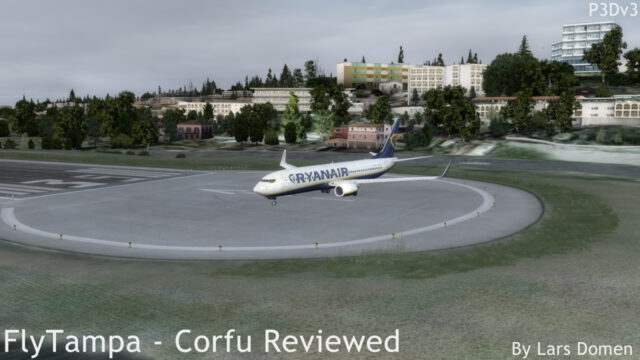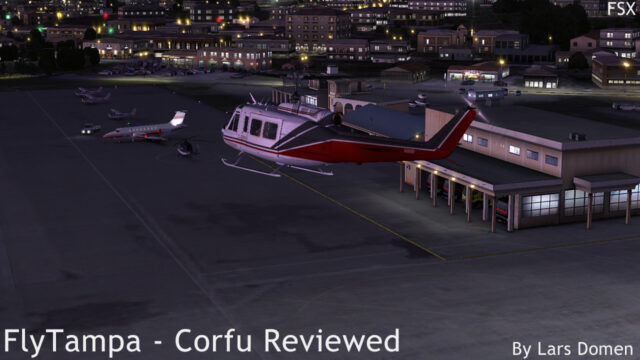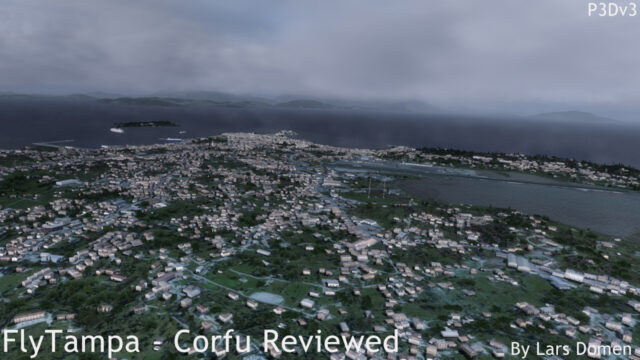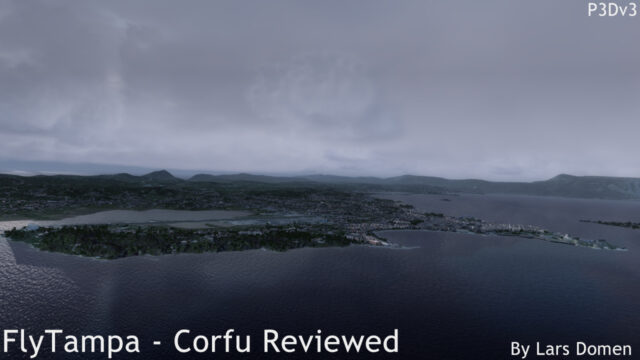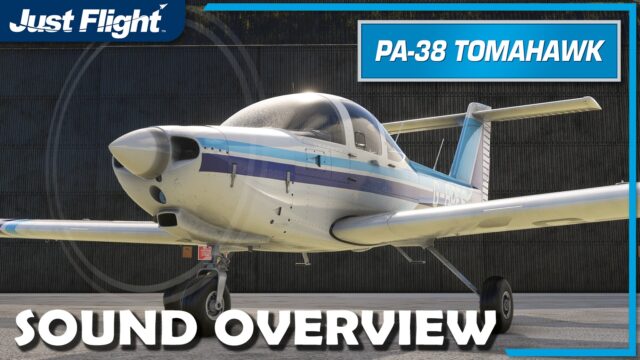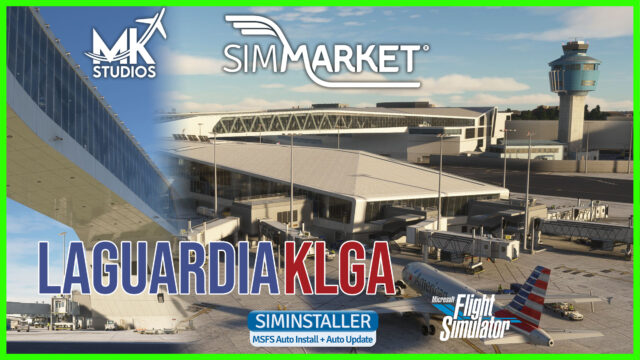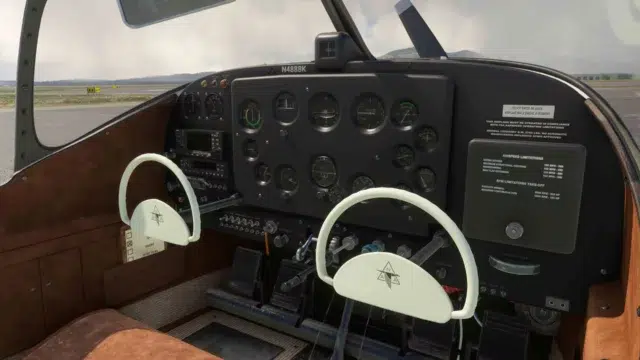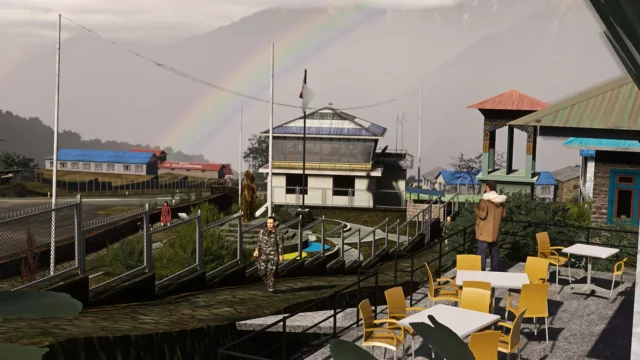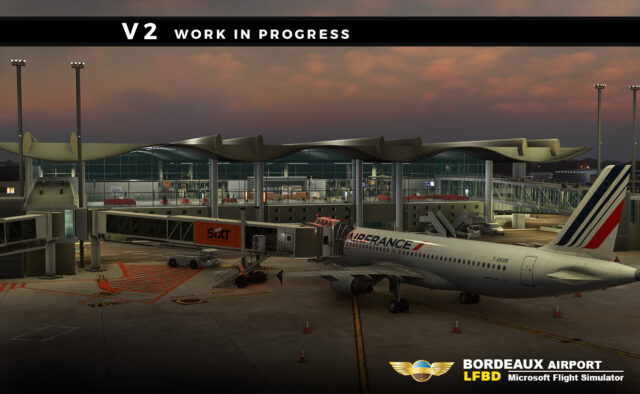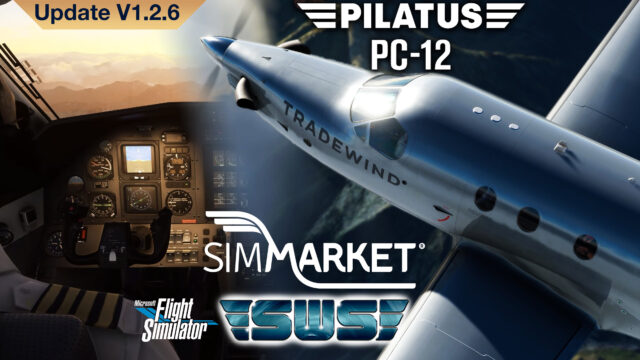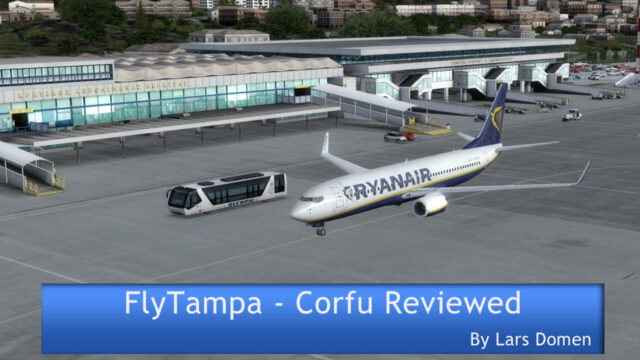 If there are scenery developers that hardly need an introduction, FlyTampa is certainly on the list. In this review, I’ll be taking a look at their newest offering: Corfu.
If there are scenery developers that hardly need an introduction, FlyTampa is certainly on the list. In this review, I’ll be taking a look at their newest offering: Corfu.
Although best known as Corfu, the Greek name of this island transliterates as Kerkyra. Corfu being the Italian (and English) name. It’s an island in the Ionian Sea just of the Greek-Albanian border. The island is closely linked with Greek Mythology. Because of its strategic location, the island also has a history of military importance. This can still be seen in the remnants of military fortifications across strategic locations around the island. The main city of the island, also named Kerkyra in Greek or Corfu in Italian and English, is enclosed by castles, for example.
The island has an area of just under 615 square km and a population of slightly more than 100000 people. The island is an important tourist destination. Visitors arrive either by ferry, or more to our interest, by plane through Corfu International Airport “Ioannis Kapodistrias”.
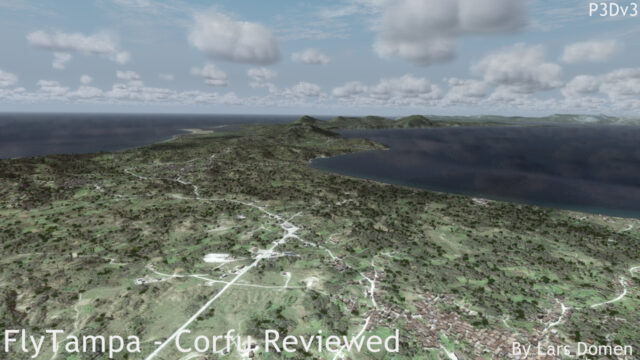
The airport (IATA: CFU, ICAO: LGKR), founded just before World War II, is located just 2km south of the city of Kerkyra/Corfu. Aircraft on approach using runway 35 offer passengers an impressive view of some distinctive landmarks.
The airport has a single 2370m long runway, numbered 17/35, both lacking an ILS. The published precision approaches are VOR approaches, all using runway 35.
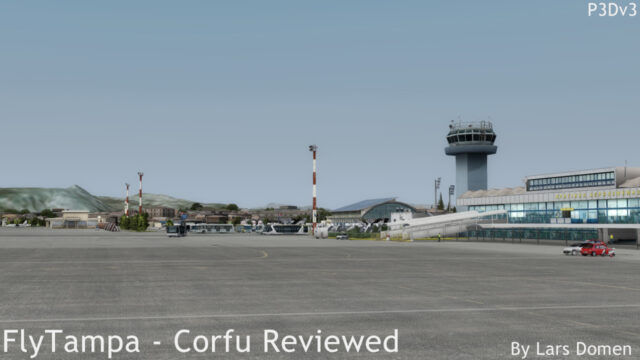
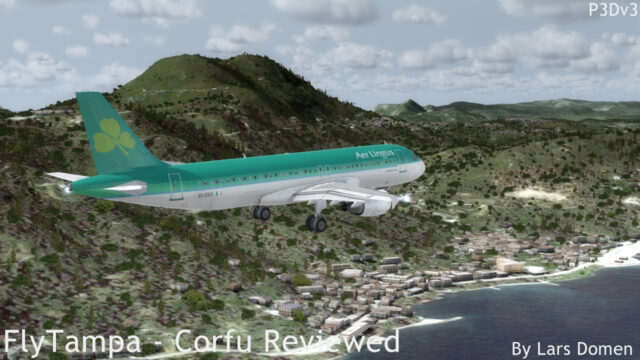
Installation:
FlyTampa’s Corfu is available from SimMarket for €24.00 (excluding VAT). While not cheap for a scenery product, the price is not over-the-top either, in my opinion. Unfortunately, the product page isn’t really clear on what versions of what simulators the product is compatible with. The only 2 explicitly stated are FSX SP2 and P3Dv3. However, FlyTampa Corfu is compatible with all versions of FSX and all versions of Prepar3D. It does not work in FS9. Note that I’m using Prepar3D v3.1 for most of the testing concerning this review, although I’ve also done some flights from Corfu in FSX Acceleration.
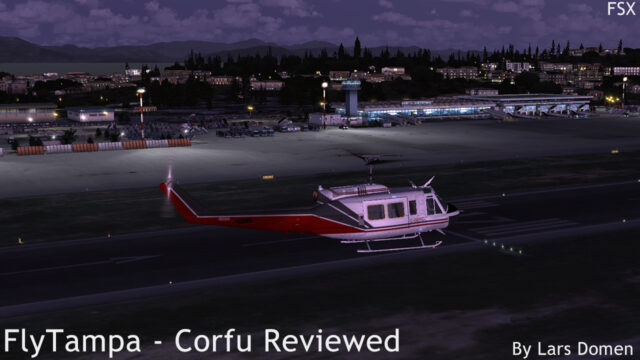
After purchase, you receive a link to a 700MB download file, and a serial code.
Installation is straight-forward and trouble free. The one step that’s a bit bothersome is that there’s no easy-to-use “pick-a-sim” menu. When you want to install to a different simulator than the one the installation suggests, you have to point it there manually. For example, I have FSX Acceleration, P3D v2 and P3D v3 installed, but the installer by default always points to my FSX installation location. It works perfectly fine when pointed to another location though. Although this seems a bit ‘unpolished’ at first, it’s a reasonable way of handling the increase in the number of related simulators the last years, without making the installers too complicated.
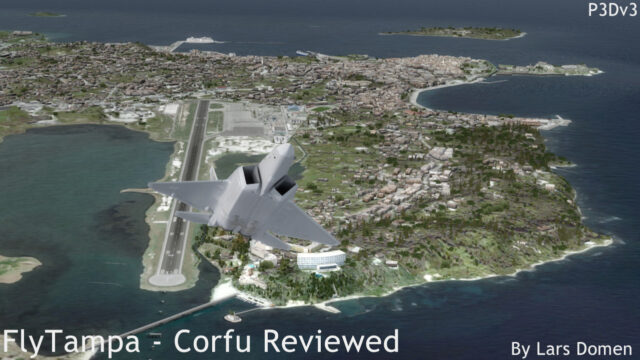
After selecting a simulator, you can choose some options, like whether to install the FlyTampa libraries, adding the scenery to the simulator.cfg file, and setting the “texture_max_load” value. After this, it’s just waiting for the installer to finish. When installed, the scenery takes up about 1.13GB of disk space. Apart from the scenery itself, you get short manual and the FlyTampa Configurator. More on that later.
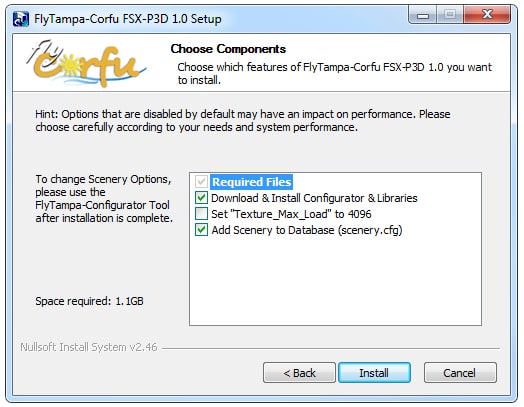
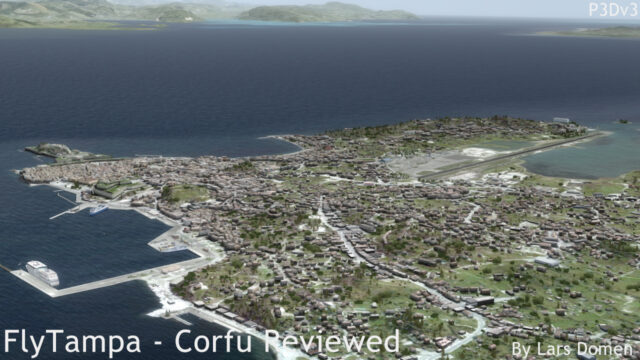
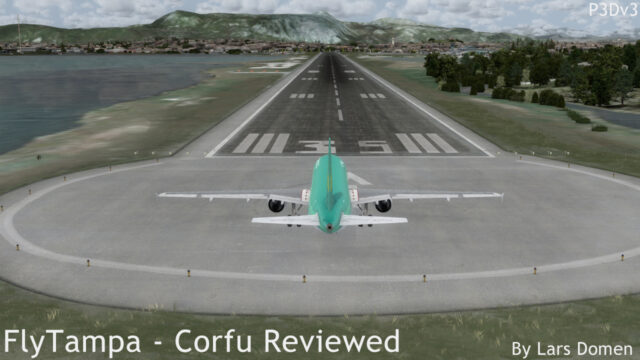
The island:
First thing to note when talking about the scenery: the entire island is covered! And I’m quite impressed. The entirety of Corfu is covered by a very detailed and beautiful looking photoreal ground texture. There are several things I like about it. First of all, it just looks believable. Green, untouched lands, cultivated fields, small towns, the large city… It’s all there for you to look at. I’m also quite fond of the small roads that criss-cross the island. It just ties it together.
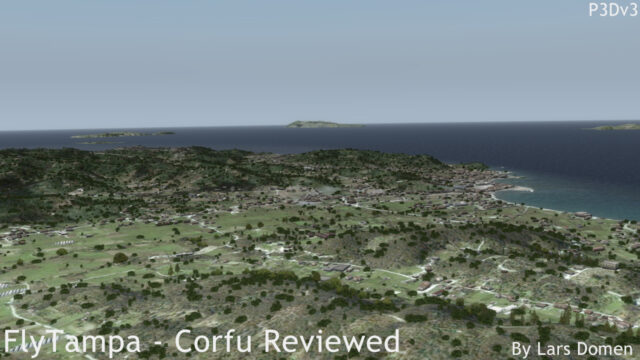
People who are used to sandy beaches might notice the lack thereof. But no worries, that’s realistic as well. The real Corfu has very few sandy beaches either.
Of course, the quality of the ground texture is heavily dependent on the ‘terrain texture resolution’ setting in your sim. The lower the resolution, the less detail you will see.
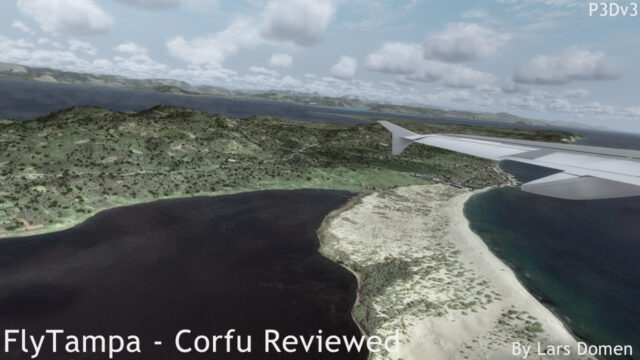
One problem that sneaked into the release version of FlyTampa’s Corfu is that 2 islands to the south of Corfu have gone missing. The islands of Paxoi and Antipaxoi appear to have sunk below the waves. Luckily, FlyTampa have managed to reverse this terrible effect of global warming with a hotfix on the support forum. I’m sure it’ll be included in a wide-release update in the future for those who don’t check forums for fixes.
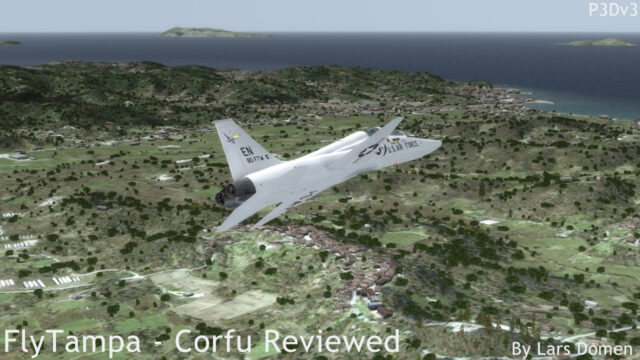
Personally, I’m not a fan of just a photoreal ground texture with nothing on it, no matter how good it looks. A lack of buildings and trees (where there should be, of course) is an instant immersion-killer for me. Luckily, FlyTampa didn’t skip on this aspect of Corfu. From north to south, and from west to east, the island is covered! When flying past the more rural parts of the island, I’m impressed by the accuracy and attention to detail that has been put into placing the autogen buildings and trees. If the ground texture shows just a couple of buildings sitting along a crossroads, you can rest assured there will be 3D autogen buildings there in the sim. Considering your settings are turned up high enough of course.
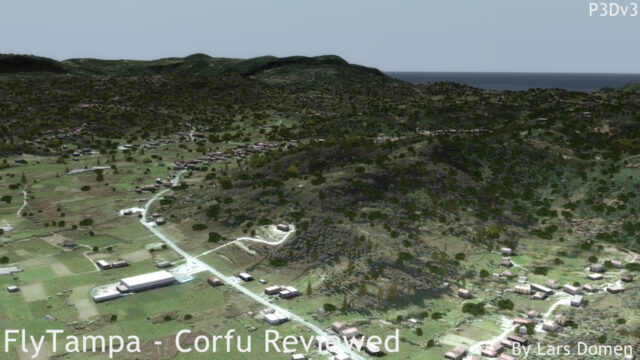
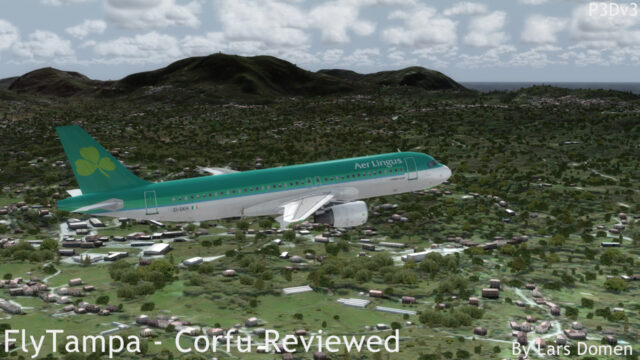
Also worth saying, is that the autogen buildings just looks good. It’s not just some generic models picked from one of the standard libraries and placed around the island. FlyTampa clearly put some effort into creating buildings that look native to Corfu. No matter if you fly over the countryside, by the coast, or over the middle of the city, the buildings just look right.
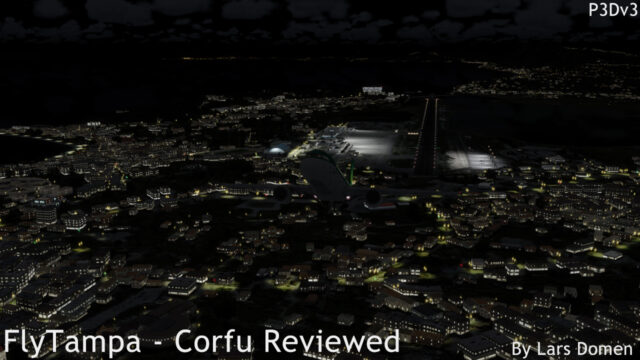
Speaking of the city, there’s a lot of detail to be found there. Of course there’s the city proper, with lots of buildings packed together. But from a scenic point of view, there are more interesting features: the port area, with ferries coming and going… The fortresses surrounding the city… All those features are present in the sim, and good looking at that.
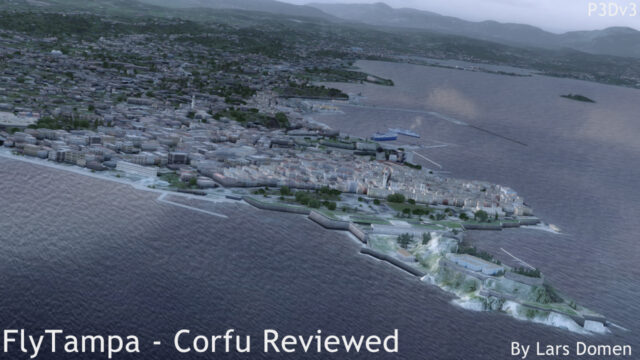
To get a bit ahead of myself, and go back to the topic of autogen density, the FlyTampa Configurator, on which more later, includes an option to reduce the autogen density closer to the airport, in order to relieve stress on the simulator on approach if needed. This is a very welcome feature for those who suffer from low frame rates or out-of-memory errors. When finally landing from a multiple-hour flight, neither of those are issues you want to see. Turning down the autogen density is probably the fastest way to get your frame rates up when needed.
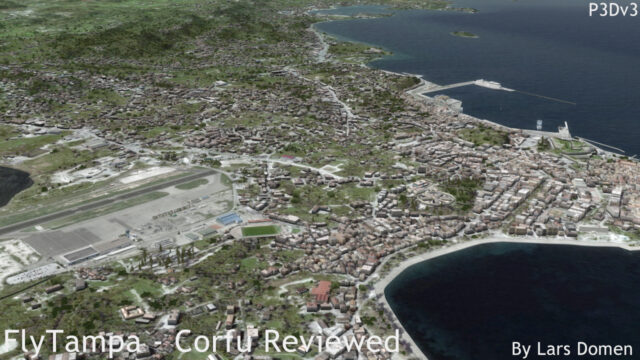
The Airport:
No matter how good the rest of the island looks, in the end, the part of this scenery product that will be seen most by the customers is the airport. Not surprising thus that a lot of work had gone into it, and its immediate area.
Starting on the ground, you get a very detailed runway, taxiways and aprons. Very good looking, very authentic feeling. One slight remark is that the yellow lines on the taxiways can look a bit faint by default. A fix for this is available on the FlyTampa forum. In installed this fix, and the result is indeed a bit better.
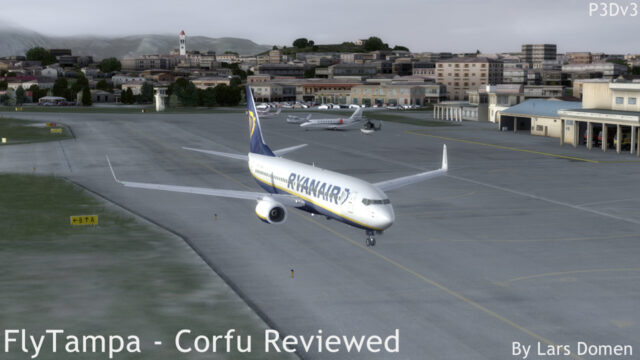
The buildings around the airport are modelled into great detail. But not only that, the textures in which they are covered are done superbly. In all, the results just look the part. They fit perfectly into the entire scenery.
When looking at the approach into runway 35, this attention to detail shows up very strongly. Aircraft pass close by some buildings here, and these buildings are modelled into quite a bit of detail. Also looking good is the bridge/dam crossing the inlet, and the stands placed in the water for the approach lights.
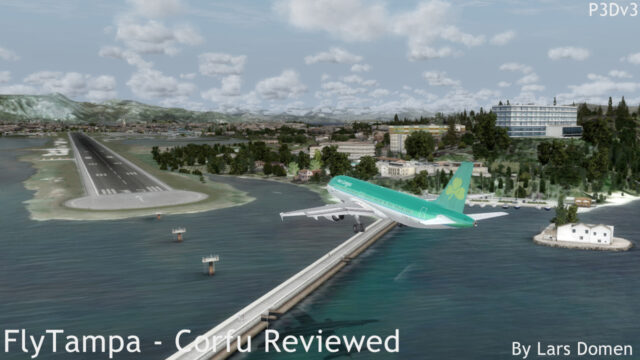
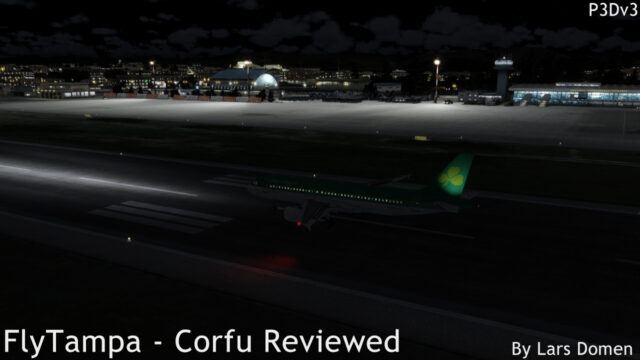
And then there’s the ‘clutter’ around the airport. Depending on the options you enable and your simulator settings, there’s volumetric grass, aircraft stairs, static aircraft and loads of other items that would clutter around the real airport. A particularly nice addition here are moving 3D people, both on the airport and other areas of the scenery.
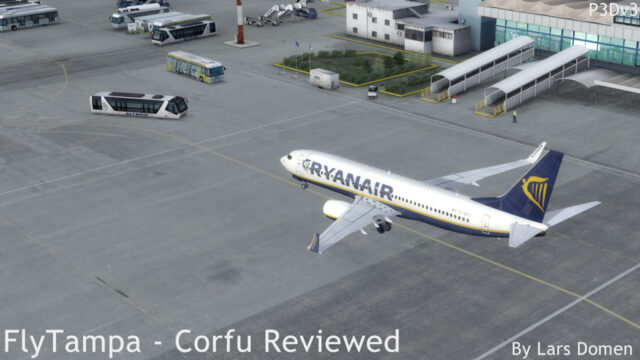
When we look at the static aircraft, first of all, they look very good. Better than most static aircraft included in scenery products. But when you enable this option, one of the parking locations they take up is not disabled in the airport selection menu, causing you to spawn into this aircraft upon launch. A small oversight probably, with, depending how you look at it, slightly bothersome to hilarious results. Luckily in this case, the static aircraft are not crash-enabled, so you can drive right through them without crashing.

Just off to the sides of the airport, there’s one of the features that drew me to this add-on in the first place. SpeedTrees! Of course, only in Prepar3D version 3. I’m not entirely sure, but I think this was the first third-party scenery product to include this technology upon release. The downside of this feature is inherent in the technology: these moving trees do impact frame rates. When disabling this option for P3D v3, or by default in any other simulator, you get ‘normal’ FS trees placed in the same locations. For ‘normal’ trees though, they do look mighty fine.
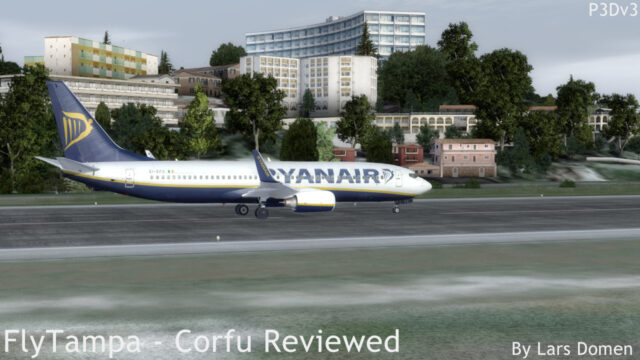
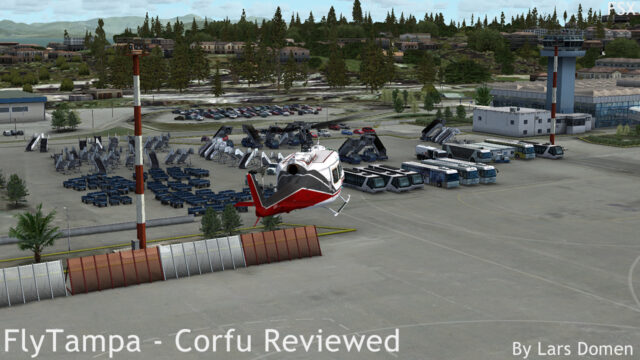
Extra’s:
The first thing I want to mention is the manual. Not much to say about it. You get an 8-page pdf manual. It’s indeed not long, but it contains all necessary information. Some background on the airport, recommended settings for FSX and P3D and a word on the configuration utility. Furthermore, a link to a low resolution texture pack (for those who have out-of-memory errors), and FAQ and finally links to relevant websites and the credits. No charts are included with the airport unfortunately. You’ll have to find those yourself.
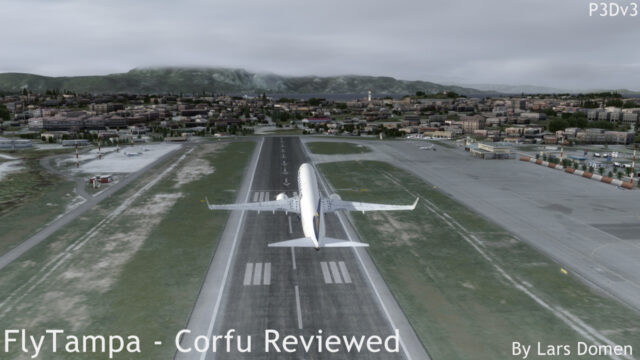
A more important ‘extra’, is the FlyTampa Configurator. This external utility is used to enable or disable some options around the scenery. There’s stuff like the SpeedTrees for P3Dv3, switching between VFR (full) and approach (reduced) autogen density on the island, switching between static and animated ferries, and more.
One of the features in the Configurator I particularly appreciate in that it gives you a rough idea of the frame rate impact the varying options have.
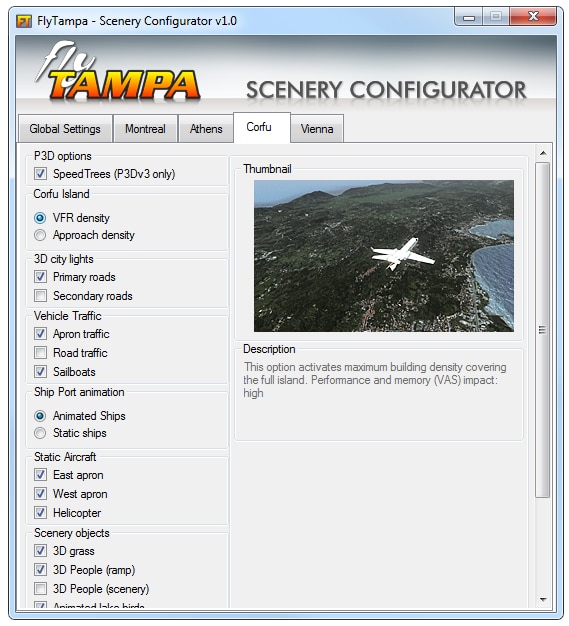
Performance:
This is a high-detail scenery product, so don’t go expecting it to run like a default airstrip without airport buildings in a barren desert. With all options enabled and high settings, this scenery product will noticeably affect frame rates. Especially when looking in the direction of the city, or the SpeedTrees in P3Dv3. Something you do by default when using runway 35. I’ve noticed that getting smooth performance at this airport is very dependent on the aircraft you’re using.
But I’ve also noticed that, as long as you’re realistic in your settings and options, you can get surprisingly good performance out of this scenery product, considering the amount of detail.
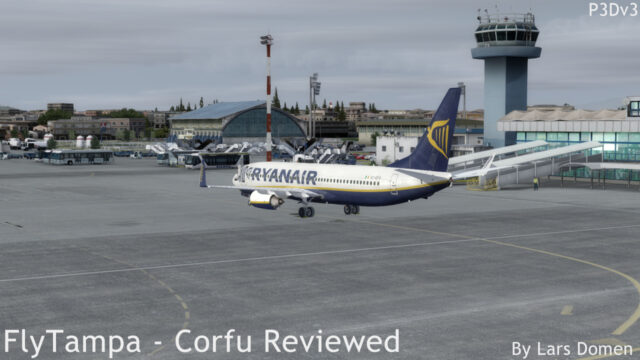
Note that the screenshots in this review were all taken at settings that are perfectly flyable on my system. No balls-to-the-wall extreme settings just for screenshots. This also means that with a more powerful PC, you can get even better results than what you’re seeing here.
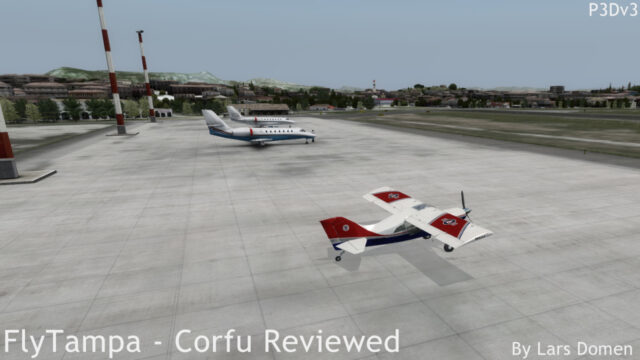
Conclusion:
FlyTampa Corfu is a beautiful scenery product covering a beautiful island. The quality you receive is exactly what you expect from FlyTampa: the best. Being a relatively new release, at still has some small issues. But FlyTampa already offer some fixes on their forum. I hope they get bundled into a full update soon, in order to reach all customers. But even without those fixes, you get an island and airport that look particularly good in whatever simulator you choose. The amount of details is high, and the quality of the work is superb. Considering all this, the performance is relatively good as well.
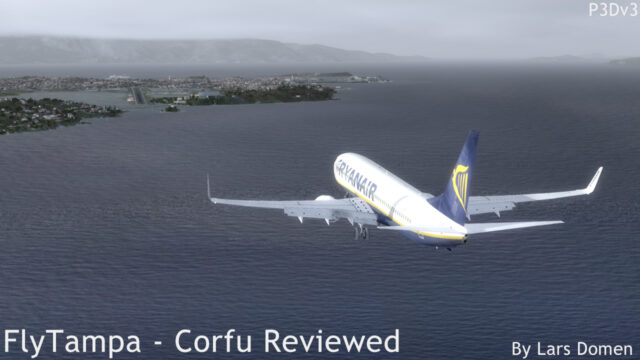
Like:
- Entire island covered
- Lots of details
- Outstanding visual quality
Don’t like:
- You can’t just turn all options and settings to maximum without consideration. It looks so incredibly good if you do, but coupled with a high-end aircraft, it’s too much for most pc’s, including mine.
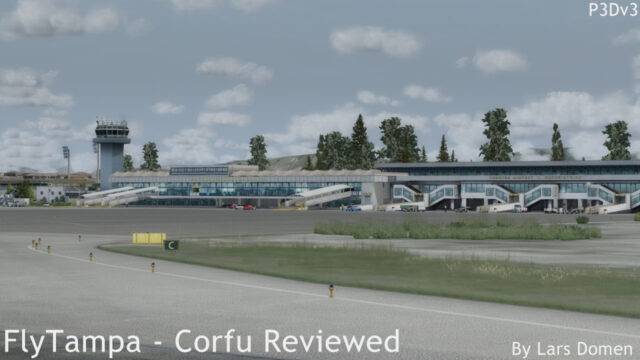
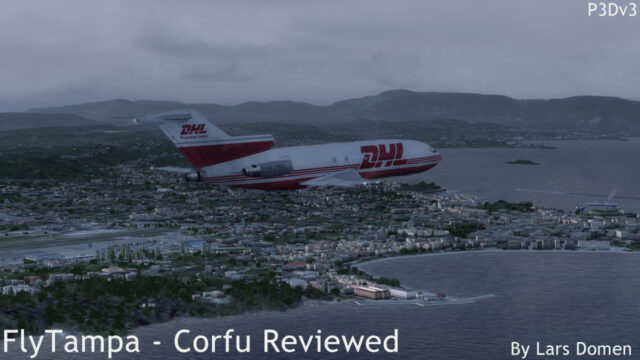
Useful links:
Test System
Intel Core i5-2500K @ 4×3.3GHz
8GB DDR3 RAM
MSI GTX 960 Gaming 2G
Windows 7 64 bit
FSX Deluxe + Acceleration
Prepar3D v2.5
Prepar3D v3.1
Click here for more details about my system.
Additional software used:
Active Sky Next
Aerosoft Airbus A320
Captain Sim 727
Dodosim 206
FSFX Packages PrecipitFX
Milviz T-38A Advanced
Orbx FTX Global
PMDG 737 NGX
Real Environment Extreme Texture Direct + Soft Clouds
Ultimate Terrain X Europe v2
